L57-主谓一致原则 初中英语词性句法新讲课件
文档属性
| 名称 | L57-主谓一致原则 初中英语词性句法新讲课件 | 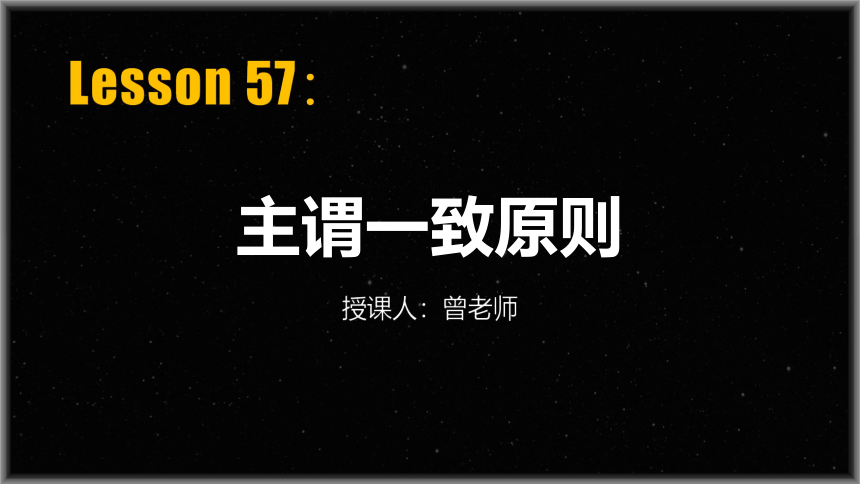 | |
| 格式 | ppt | ||
| 文件大小 | 994.5KB | ||
| 资源类型 | 试卷 | ||
| 版本资源 | 通用版 | ||
| 科目 | 英语 | ||
| 更新时间 | 2022-04-11 09:59:54 | ||
图片预览

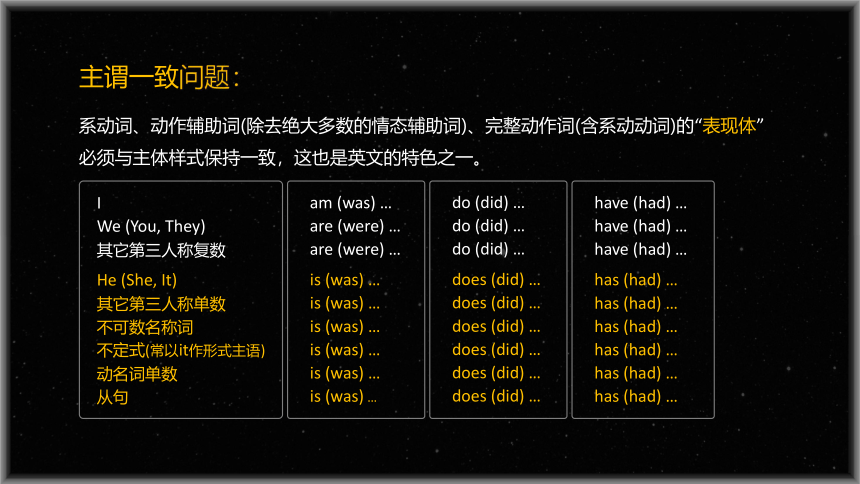
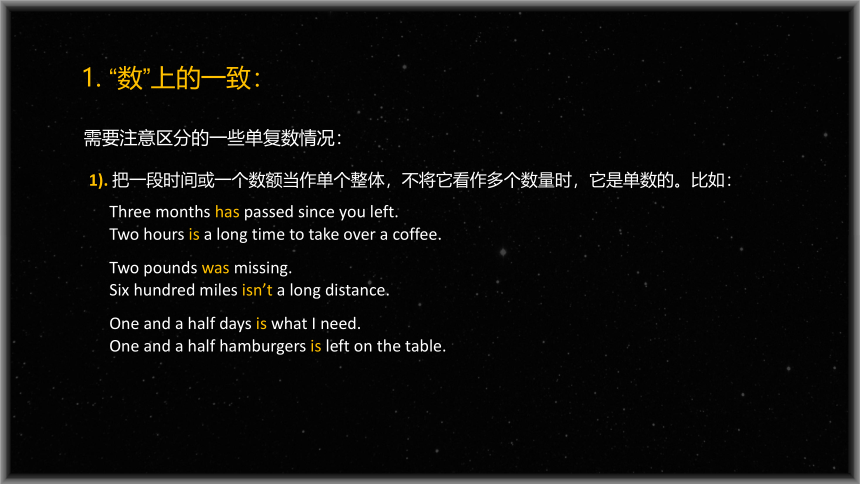
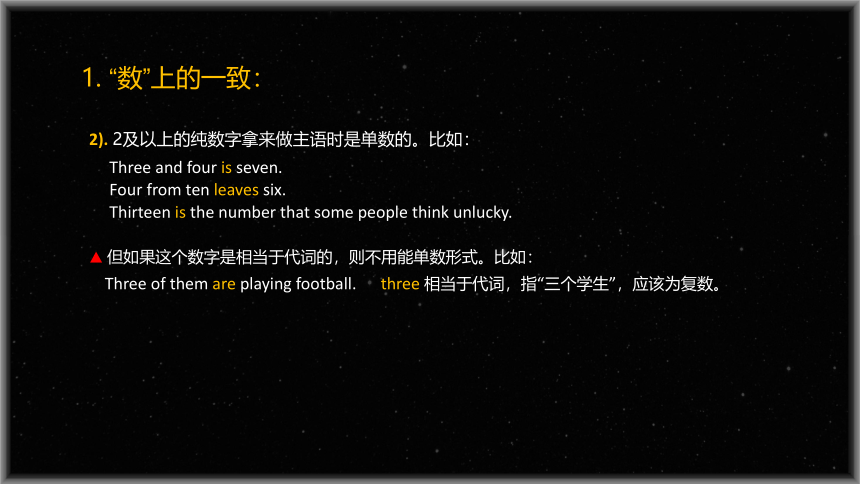
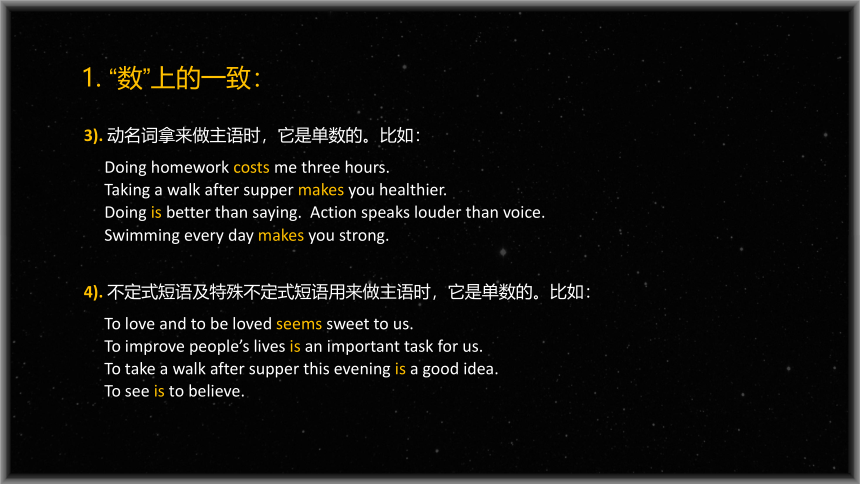
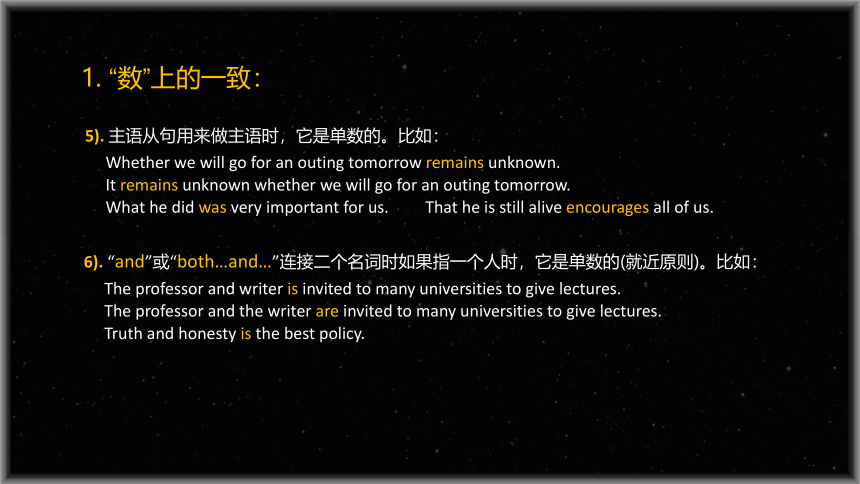
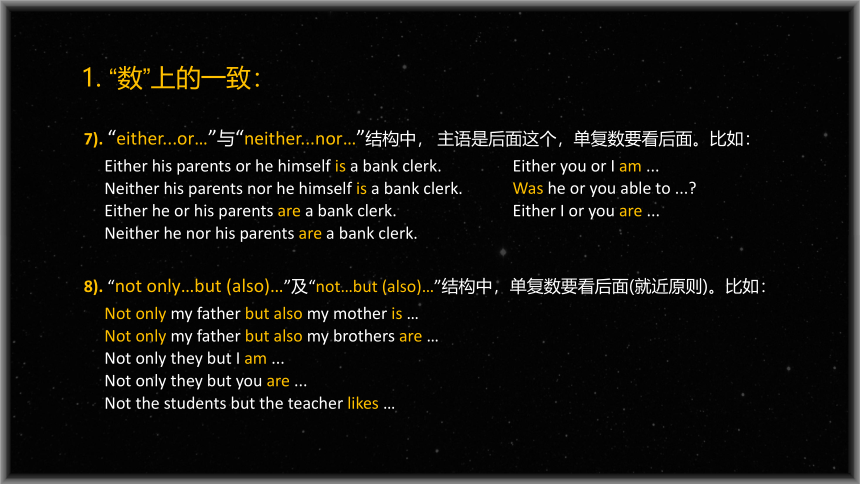
文档简介
(共14张PPT)
主谓一致原则
Lesson 57:
授课人:曾老师
系动词、动作辅助词(除去绝大多数的情态辅助词)、完整动作词(含系动动词)的“表现体”
必须与主体样式保持一致,这也是英文的特色之一。
主谓一致问题:
I
We (You, They)
其它第三人称复数
He (She, It)
其它第三人称单数
不可数名称词
不定式(常以it作形式主语)
动名词单数
从句
do (did) …
do (did) …
do (did) …
does (did) …
does (did) …
does (did) …
does (did) …
does (did) …
does (did) …
have (had) …
have (had) …
have (had) …
has (had) …
has (had) …
has (had) …
has (had) …
has (had) …
has (had) …
am (was) …
are (were) …
are (were) …
is (was) …
is (was) …
is (was) …
is (was) …
is (was) …
is (was) …
需要注意区分的一些单复数情况:
1). 把一段时间或一个数额当作单个整体,不将它看作多个数量时,它是单数的。比如:
Three months has passed since you left.
Two hours is a long time to take over a coffee.
Two pounds was missing.
Six hundred miles isn’t a long distance.
One and a half days is what I need.
One and a half hamburgers is left on the table.
1. “数”上的一致:
1. “数”上的一致:
Three and four is seven.
Four from ten leaves six.
Thirteen is the number that some people think unlucky.
2). 2及以上的纯数字拿来做主语时是单数的。比如:
▲ 但如果这个数字是相当于代词的,则不用能单数形式。比如:
Three of them are playing football. three 相当于代词,指“三个学生”,应该为复数。
Doing homework costs me three hours.
Taking a walk after supper makes you healthier.
Doing is better than saying. Action speaks louder than voice.
Swimming every day makes you strong.
3). 动名词拿来做主语时,它是单数的。比如:
1. “数”上的一致:
To love and to be loved seems sweet to us.
To improve people’s lives is an important task for us.
To take a walk after supper this evening is a good idea.
To see is to believe.
4). 不定式短语及特殊不定式短语用来做主语时,它是单数的。比如:
Whether we will go for an outing tomorrow remains unknown.
It remains unknown whether we will go for an outing tomorrow.
What he did was very important for us. That he is still alive encourages all of us.
5). 主语从句用来做主语时,它是单数的。比如:
1. “数”上的一致:
The professor and writer is invited to many universities to give lectures.
The professor and the writer are invited to many universities to give lectures.
Truth and honesty is the best policy.
6). “and”或“both…and…”连接二个名词时如果指一个人时,它是单数的(就近原则)。比如:
1. “数”上的一致:
Not only my father but also my mother is …
Not only my father but also my brothers are …
Not only they but I am ...
Not only they but you are ...
Not the students but the teacher likes …
8). “not only…but (also)…”及“not…but (also)…”结构中,单复数要看后面(就近原则)。比如:
Either his parents or he himself is a bank clerk.
Neither his parents nor he himself is a bank clerk.
Either he or his parents are a bank clerk.
Neither he nor his parents are a bank clerk.
7). “either...or…”与“neither...nor…”结构中, 主语是后面这个,单复数要看后面。比如:
Either you or I am ...
Was he or you able to ...
Either I or you are ...
1. “数”上的一致:
Many a student here comes from Spain.
More than one way has been tried to stop pollution.
9). “many a …, more than one…”结构中,主语仍然是单数的。比如:
Someone has parked the car in the way.
Everything is OK now.
10). “someone, something, everyone, everything”等做主语时,它是单数的。比如:
Each student likes ..., Each of the students likes ..., They each like ...
11). “each”作为代词做主语时是单数的;用作副词时,则要看主语情况。比如:
1. “数”上的一致:
Some of the music was weird.
Some of the biggest names in the art world were at the party.
All are present except Mr. Smith.
All is going on very well.
Enough has been done to stop him from crying.
People are losing money in musicals, but enough are making money.
The rest is up to you.
Many of its rivers have dried up, and the rest are heavily polluted.
Part of the story is true.
Part of the foreign teachers are from Canada in our school.
The majority of workers are for his proposal.
The majority of the population here is Christian.
12). “all, enough, some, rest, part, majority”等用来修饰或指代可数名词时是复数的;
但用来修饰或指代不可数名词时是单数的:
1. “数”上的一致:
People are not interested in movies anymore.
The police are also looking for a second car.
The Chinese are hard-working.
The English like to be with their families at Christmas.
13). 有些集称类名词,我们把它们看作是复数的。比如:
people是person的复数形式
代表警察们
相当于Chinese people.
His family was poor when he was young.
My family are going to a trip this winter.
14). 有些集称类名词,把它视为一个整体时是单数,视为全体成员时是复数的。比如:
视为单个整体
视为全体成员
The team is in the dressing room.
The team are fighting among themselves.
视为单个整体
视为全体成员
1. “数”上的一致:
A number of houses were burnt down in the fire.
The number of companies offering them work increases.
16). “a number of …”是复数的; “the number of …”是单数的。比如:
One and a half days is what I need.
One and a half hamburgers is left on the table.
15). “one and a half…”一般视为单数形式。比如:
1. “数”上的一致:
Apple is expected to release a new phone this year.
The New York Times has lots of readers.
General Motors is once again the world's largest producer of vehicles.
Texas Instruments is a large producer of electronics here.
British Airways is an airline company in Europe.
18). 指一个人/事/物/公司/国家的专有名称,一般都视为单数形式。比如:
The old are taken good care of in our country.
The poor/rich/honest/… are …
17). “限定词+形容词”构成的名称,指可数名称物的多个时是复数的;
指单个或不可数名词时是单数的:
The first is the best.
The new is sure to replace the old.
1. “数”上的一致:
19). “one of ...”与“the only one of ...”结构中,后置定语从句中的单复数:
传统语法认为,“one of ...”后面定语从句中的主语是复数的;而“the only one of ...”
结构中后面定语从句中的主语是单数的。比如:
He is one of the students who were praised at the meeting.
He is the only one of the students who was praised at the meeting.
但实际上,“one of ...”后面定语从句中的主语也可以是单数的。比如:
This is one of best books that has appeared this year.
One of the links in the chain that drives the wheels had snapped(断裂).
He’s one of those students who never get(s) a piece of work done on time.
▲ 如果是考试,就按上面的规则来。实则上是要看定语从句到底修饰哪一个。
There is a lake in the park. There are some lakes ....
There stands a big tree on the top of the hill. There stand some trees ....
Look! Here come Mr. Brown and Mrs. brown.
However, still here comes the rain and there goes the friend.
20). 倒装句中,根据其后主语的单复数情况来定。比如:
1. “数”上的一致:
▲ 如果主语中有二个名称,且第一个为单数,则往往根据就近原则用单数形式。比如:
There is a girl and a boy in the classroom.
There is a lake and many trees near the house.
Is there a desk, a computer and some books in your room
主谓一致原则
Lesson 57:
授课人:曾老师
系动词、动作辅助词(除去绝大多数的情态辅助词)、完整动作词(含系动动词)的“表现体”
必须与主体样式保持一致,这也是英文的特色之一。
主谓一致问题:
I
We (You, They)
其它第三人称复数
He (She, It)
其它第三人称单数
不可数名称词
不定式(常以it作形式主语)
动名词单数
从句
do (did) …
do (did) …
do (did) …
does (did) …
does (did) …
does (did) …
does (did) …
does (did) …
does (did) …
have (had) …
have (had) …
have (had) …
has (had) …
has (had) …
has (had) …
has (had) …
has (had) …
has (had) …
am (was) …
are (were) …
are (were) …
is (was) …
is (was) …
is (was) …
is (was) …
is (was) …
is (was) …
需要注意区分的一些单复数情况:
1). 把一段时间或一个数额当作单个整体,不将它看作多个数量时,它是单数的。比如:
Three months has passed since you left.
Two hours is a long time to take over a coffee.
Two pounds was missing.
Six hundred miles isn’t a long distance.
One and a half days is what I need.
One and a half hamburgers is left on the table.
1. “数”上的一致:
1. “数”上的一致:
Three and four is seven.
Four from ten leaves six.
Thirteen is the number that some people think unlucky.
2). 2及以上的纯数字拿来做主语时是单数的。比如:
▲ 但如果这个数字是相当于代词的,则不用能单数形式。比如:
Three of them are playing football. three 相当于代词,指“三个学生”,应该为复数。
Doing homework costs me three hours.
Taking a walk after supper makes you healthier.
Doing is better than saying. Action speaks louder than voice.
Swimming every day makes you strong.
3). 动名词拿来做主语时,它是单数的。比如:
1. “数”上的一致:
To love and to be loved seems sweet to us.
To improve people’s lives is an important task for us.
To take a walk after supper this evening is a good idea.
To see is to believe.
4). 不定式短语及特殊不定式短语用来做主语时,它是单数的。比如:
Whether we will go for an outing tomorrow remains unknown.
It remains unknown whether we will go for an outing tomorrow.
What he did was very important for us. That he is still alive encourages all of us.
5). 主语从句用来做主语时,它是单数的。比如:
1. “数”上的一致:
The professor and writer is invited to many universities to give lectures.
The professor and the writer are invited to many universities to give lectures.
Truth and honesty is the best policy.
6). “and”或“both…and…”连接二个名词时如果指一个人时,它是单数的(就近原则)。比如:
1. “数”上的一致:
Not only my father but also my mother is …
Not only my father but also my brothers are …
Not only they but I am ...
Not only they but you are ...
Not the students but the teacher likes …
8). “not only…but (also)…”及“not…but (also)…”结构中,单复数要看后面(就近原则)。比如:
Either his parents or he himself is a bank clerk.
Neither his parents nor he himself is a bank clerk.
Either he or his parents are a bank clerk.
Neither he nor his parents are a bank clerk.
7). “either...or…”与“neither...nor…”结构中, 主语是后面这个,单复数要看后面。比如:
Either you or I am ...
Was he or you able to ...
Either I or you are ...
1. “数”上的一致:
Many a student here comes from Spain.
More than one way has been tried to stop pollution.
9). “many a …, more than one…”结构中,主语仍然是单数的。比如:
Someone has parked the car in the way.
Everything is OK now.
10). “someone, something, everyone, everything”等做主语时,它是单数的。比如:
Each student likes ..., Each of the students likes ..., They each like ...
11). “each”作为代词做主语时是单数的;用作副词时,则要看主语情况。比如:
1. “数”上的一致:
Some of the music was weird.
Some of the biggest names in the art world were at the party.
All are present except Mr. Smith.
All is going on very well.
Enough has been done to stop him from crying.
People are losing money in musicals, but enough are making money.
The rest is up to you.
Many of its rivers have dried up, and the rest are heavily polluted.
Part of the story is true.
Part of the foreign teachers are from Canada in our school.
The majority of workers are for his proposal.
The majority of the population here is Christian.
12). “all, enough, some, rest, part, majority”等用来修饰或指代可数名词时是复数的;
但用来修饰或指代不可数名词时是单数的:
1. “数”上的一致:
People are not interested in movies anymore.
The police are also looking for a second car.
The Chinese are hard-working.
The English like to be with their families at Christmas.
13). 有些集称类名词,我们把它们看作是复数的。比如:
people是person的复数形式
代表警察们
相当于Chinese people.
His family was poor when he was young.
My family are going to a trip this winter.
14). 有些集称类名词,把它视为一个整体时是单数,视为全体成员时是复数的。比如:
视为单个整体
视为全体成员
The team is in the dressing room.
The team are fighting among themselves.
视为单个整体
视为全体成员
1. “数”上的一致:
A number of houses were burnt down in the fire.
The number of companies offering them work increases.
16). “a number of …”是复数的; “the number of …”是单数的。比如:
One and a half days is what I need.
One and a half hamburgers is left on the table.
15). “one and a half…”一般视为单数形式。比如:
1. “数”上的一致:
Apple is expected to release a new phone this year.
The New York Times has lots of readers.
General Motors is once again the world's largest producer of vehicles.
Texas Instruments is a large producer of electronics here.
British Airways is an airline company in Europe.
18). 指一个人/事/物/公司/国家的专有名称,一般都视为单数形式。比如:
The old are taken good care of in our country.
The poor/rich/honest/… are …
17). “限定词+形容词”构成的名称,指可数名称物的多个时是复数的;
指单个或不可数名词时是单数的:
The first is the best.
The new is sure to replace the old.
1. “数”上的一致:
19). “one of ...”与“the only one of ...”结构中,后置定语从句中的单复数:
传统语法认为,“one of ...”后面定语从句中的主语是复数的;而“the only one of ...”
结构中后面定语从句中的主语是单数的。比如:
He is one of the students who were praised at the meeting.
He is the only one of the students who was praised at the meeting.
但实际上,“one of ...”后面定语从句中的主语也可以是单数的。比如:
This is one of best books that has appeared this year.
One of the links in the chain that drives the wheels had snapped(断裂).
He’s one of those students who never get(s) a piece of work done on time.
▲ 如果是考试,就按上面的规则来。实则上是要看定语从句到底修饰哪一个。
There is a lake in the park. There are some lakes ....
There stands a big tree on the top of the hill. There stand some trees ....
Look! Here come Mr. Brown and Mrs. brown.
However, still here comes the rain and there goes the friend.
20). 倒装句中,根据其后主语的单复数情况来定。比如:
1. “数”上的一致:
▲ 如果主语中有二个名称,且第一个为单数,则往往根据就近原则用单数形式。比如:
There is a girl and a boy in the classroom.
There is a lake and many trees near the house.
Is there a desk, a computer and some books in your room
同课章节目录
- 词法
- 名词
- 动词和动词短语
- 动词语态
- 动词时态
- 助动词和情态动词
- 非谓语动词
- 冠词
- 代词
- 数词和量词
- 形容词副词及其比较等级
- 介词和介词短语
- 连词和感叹词
- 构词法
- 相似、相近词比较
- 句法
- 陈述句
- 一般疑问句和否定疑问句
- 特殊疑问句及选择疑问句
- 反意疑问句
- 存在句(There be句型)
- 宾语从句
- 定语从句
- 状语从句
- 主谓一致问题
- 简单句
- 并列句
- 复合句
- 主谓一致
- 主、表语从句
- 名词性从句
- 直接引语和间接引语
- 虚拟语气
- 感叹句
- 强调句
- 倒装句
- 祈使句
- 句子的成分
- 句子的分类
- 题型专区
- 单项选择部分
- 易错题
- 完形填空
- 阅读理解
- 词汇练习
- 听说训练
- 句型转换
- 补全对话
- 短文改错
- 翻译
- 书面表达
- 任务型阅读
- 语法填空
- 其他资料
